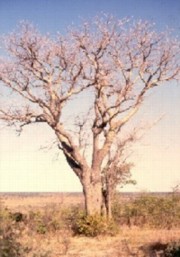

Common Names:
mongongo nut, feather weight tree
Genus: Schinziophyton
Species: rautanenii

The African savanna is a lush area filed with life. There are many trees in this area, one of them, unknown by many, is the manketti tree. The Schinziophyton rautanenii (formally known as the Ricinodendron) is found in the African savanna. Its habitat is dotted with trees and does not receive enough rain to be considered a prairie. The countries that lie in this biome are Mauritania, Guinea, Liberia, Ethiopia, Sudan, Chad, Mali, Niger and Uganda. The savanna has two seasons, summer and winter. Temperatures average from about 68 to 86 degrees F (20 to 25 degrees C). The average precipitation ranges from 10 to 30 inches (100 to 150 cm) per year. It lies between 20° North to 34° South latitude and 15° to 35° East longitude. Most the of southern and eastern part of Africa is more than 3,000 feet above sea level while the western, northern and central parts are between 500 to 2,000 feet. The savanna has a long dry season and is filled with many grasses and scattered clumps of trees.
Some common names for this tree are manketti tree, mongongo nut and featherweight tree. The manketti tree prefers hot and dry climates with low amounts of rain. It also prefers to grow in wooded hills and sand dunes. The manketti tree has a large, straight trunk with stubby and contorted branches and a large spreading crown. It has an upright manner of growth and is about 49 to 66 feet (15 to 20) meters tall. The leaves are a distinctive hand shape and are compound. The leaflet is a wide lance to an egg shape. They are composed of seven leaflets that are carried on hairy stalks that are up to 6 inches (15 cm) in length. The leaves are about 6 inches (15 cm) long and both sides are dark green in color. They are covered in fine hairs and are arranged alternately on branches.
The flowers are somewhat oval in shape, and are about 1 1/4 inch (3.5 cm) long, 3/4 inch (2.5 cm) wide, and are about 1/2 inch (10 mm) in diameter. They flower in early summer. The whitish flowers are carried in slender loose spays.
The taproot on the manketti tree goes down until it reaches water. In this case, it is long because it is located in the savanna. The lateral root is very small. The manketti tree is deciduous. It has made many adaptations to its environment including a trunk that can store water, a long taproot to reach water, thick bark to resist annual fires and leaves that drop off in the winter to conserve water.
The manketti tree is distributed widely throughout the southern savanna (South Africa etc.). It is considered a rapid growing tree and has been designated a protected tree in Namibia since 1952, probably because of its socioeconomic importance. Also, the nuts and fruit are very popular and are part of the African daily diet. The nuts also give oil and are considered one of the most important nuts in Africa. The fruit is about 1 1/4 inches (35 mm) long and 1 inch (25 mm) wide. The fruit ripens on the ground and the color turns from the original yellow to reddish brown with ripening. This tree is important to African life and will hopefully continue to prosper in the wild.
by Beau M. 2003
Bibliography:
Photo credit: "Manketti.jpg" - http://www.polytechnic.edu.na/natural/staff/pgraz/net_resources/species_notes/schinziophyton/introduction.html
Bolen, Eric G. "Biome". World Book Millennium. Volume 2. World book, inc. Chicago. 2000.
Fruit and Nut Trees
for Desert Areas. http://www.hort.purdue.edu/newcrop/proceedings1990/
v1-355.html#INTRODUCTION.
1/6/03
Lombard, Cyril. "Manketti." http://www.sanprota.com/products/manketti.html. 1/6.03.
"Savanna". http://www.blueplanetbiomes.org/savanna.htm. 1/6/03.
The
Mongongo.Manketti Nut. http://www.naturalhub.com/natrul_food_nuts_uncommon
_Ricinodendron_rautanenii.html.
1/6/03.
Walter, Walter S. Africa. World Book Millennium. Volume 1. World book, inc. Chicago. 2000.